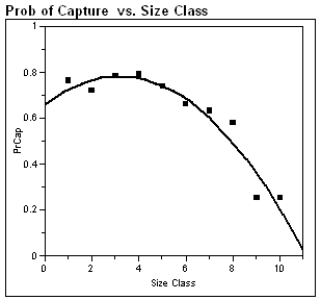A common statistical method for estimating a population size assumes each member of the population has an equal probability of being captured. To assess this assumption for crocodile populations, investigators repeatedly sampled sections of rivers in Australia. Crocodile lengths were measured in size classes. Crocs 0.0 - 0.3 meters in length are in size class 1, 0.3 - 0.6 meters in length are size class 2, etc. The normal maximum adult length is in a class size of 9 or 10. The investigators fit a quadratic function relating the probability of capture and the size class of captured crocodiles. The output from their analysis is shown below.  Polynomial Fit Degree=2
Polynomial Fit Degree=2
PrCap = 0.66 + 0.77Class − 0.01(Class)^2 

(a)What proportion of the variability in probability of capture is explained by the crocodile's size class?
(b)Some biologists speculate that as crocodiles grow they become more wary of humans, and are more difficult to detect in the wild. Support or refute this belief by appealing to the analysis above.
Definitions:
Behavioral Segmentation
The process of dividing a market into groups based on consumer behaviors, such as purchasing habits or product usage.
Consumer Comparison
The process by which consumers evaluate multiple products, services, or providers against each other based on criteria such as price, quality, and features.
Goods And Services
Products and activities that fulfill the needs or wants of consumers, where goods are physical items and services are intangible benefits.
Ethical Concerns
Matters or situations involving principles of right and wrong behavior that require individuals or organizations to evaluate and act according to ethical standards.
Q4: Each person in a random sample of
Q11: A treatment is any particular combination of
Q18: Suppose that a particular candidate for public
Q26: Assume you had a 74-year-old client who
Q28: Data on x = the weight of
Q30: In evaluating an experiment, how would you
Q36: Clara is a reporter of a local
Q43: Researchers conducted a survey among 1793 families
Q55: In a study of how college students
Q103: Explain why marketing efforts should be oriented